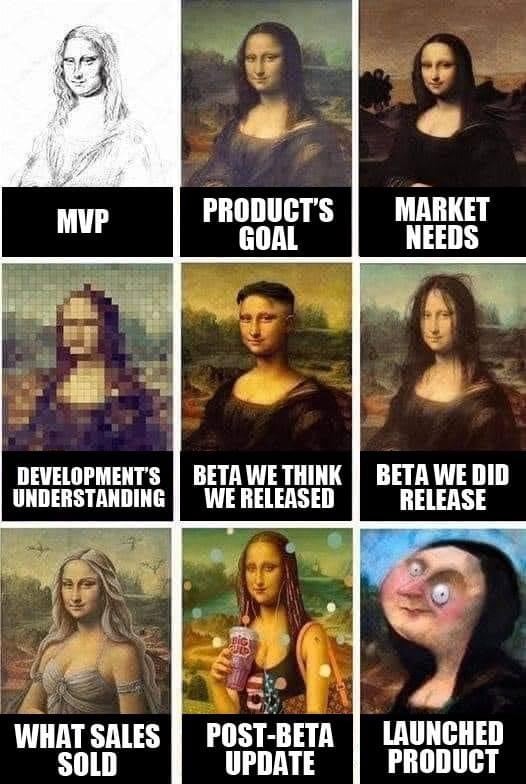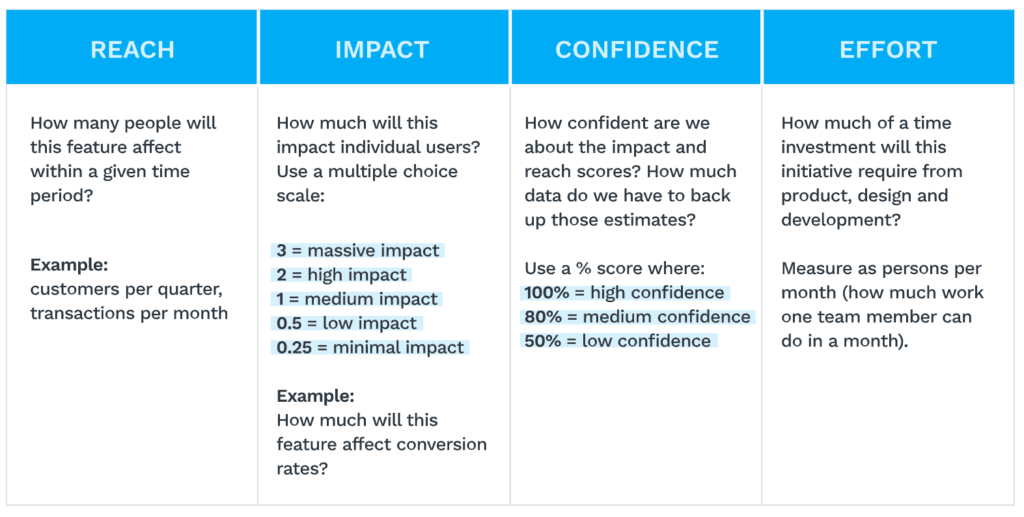Making an impact is any company’s goal. And since product managers are at the intersection of business, user-experience and tech departments, they are essentially the driving force that sets sail your company’s future trajectory in motion.
Most people think that “impact” is synonymous with “innovation”, but that is not always the case. Companies prioritize being the “trailblazer” among big dogs — and this mindset can make-or-break their company’s projected growth and development in the eyes of the market.There are always these windows of opportunities that product managers have to look out for in order to get that desired impact. And in order for you to know what features or initiatives that you want to put on your roadmaps, you need to get a hand on prioritization frameworks — and one in particular that can help you shape a better impact, through the RICE framework.
In this article
The basics
First off, if you feel intimidated, don’t be! It may look like a heavy-handed responsibility, but at the core, the main goal that product managers should be responding to when deciding to create a new product is the same initiative that made them create an initial product in the first place: solving real customer problems. And to do this, a prioritization framework is used by product managers.
A prioritization framework is a set of consistent criteria that works like a “checklist” for product teams when assessing features in priority order or according to business value. These prioritization frameworks are designed to increase product strategy, and thereby minimize inherent biases, producing more mindful decisions and avoiding information overload.
Setting up a good framework makes it much convenient to communicate your priorities to everyone, from your team to your stakeholders to even your leads. This helps you out in acquiring a good avenue for making tradeoff decisions as a leader.
Likewise, having a prioritization framework in itself is an ever-continuous study. Having empirical data in product management is a keen way to help you observe and have quantifiable results on whether your projected forecast really is effective. That way, if an idea sticks by using a specific framework, then you can use it repeatedly to help you gain more leads and quantify increments of gradual improvements.

What is the RICE Framework?
The RICE prioritization framework is designed to help product managers determine your leading features, products or initiatives to put out there for your target customers by scoring through four factors. RICE is an acronym for reach, impact, confidence, and effort.
The RICE framework is a pretty neat way to help you sort out decisions and minimize personal biases when you are trying to figure out if the targeted feature that you want to change in your new product line is projectively better. It lets you have a clear foresight on these windows of opportunities in the market on deciding when and why you need to put this improvement out there.
A Quick Story Time About the RICE Model
The spearhead in creating this ingenious prioritization framework is the messaging-software maker Intercom. During that time, the company’s product team was having a hard time to fit other available prioritization models to their unique project ideas, so they came up with their own, which is the RICE model–proving that if you can’t find a fitting solution, make up your own!
Intercom’s product team tailor-fitted these prominent factors which helped them absolve whether or not a prospective idea will get the pulse of the masses. With this model, it allowed them to design a formula that outputs a single score, which maintains uniformity and objectivity, helping them decide which idea to prioritize first among a pool of competing suggestions.
Why choose RICE prioritization framework?
The RICE Prioritization Framework allows you to have a flexible and realistic forecast of an idea. So you’ll know that it has a higher probability of adoption. Here are a few reasons why it’s a champion for project managers:
- Shows a bigger, more comprehensive picture: The final RICE score includes factors that show a bigger picture of a projected idea, realistically. The final data is empirical and backed up by reliable and accurate data, rather than based on emotion and guesswork.
- Practical Metrics: Since you’ll be basing off your scores from actual data and effective KPIs, then you are certain that you’ll have accurate estimates.
- Customer-centric: The best thing about RICE is that its central idea focuses on user experience so you know that you’ll be taking into account your user satisfaction before even starting!
- Scalable: It allows you to simplify the options, especially if your foresight in a project includes numerous additional features. It will make your decision-making much, much more convenient as more and more features are taken into consideration.
How Does It Work, Then?

To use the RICE scoring model, you need to evaluate each idea by scoring them by a formula in each of RICE’s key factors.
Reach
As the name suggests, this first factor allows you to get a sense of the extent of your target demographic under a given period of time.
It’s worth noting that you get to decide the time frame you need to set over, which you’ll need to measure your results. Over that course of time, you get to estimate how many existing users are checking out your new prospective feature, the projected number of customer transactions, and free-trial signups.
Take this as an example: say that your project will yield 100 new customers within a span of a month. Your reach score will be 100. In cases of free-trials, you get to estimate the amount of downloads you will accumulate over this period, and how many prospective users will join. So if you are projecting that with 1,500 people trial-downloading in the next month and you estimate that it will yield a 30% sign-up increase, then your reach score will be at 450.
Impact
Impact tends to be the RICE framework’s silver lining when it comes to producing a nice, even score. It’s because it poses an important question to you and your projected leads: “why?”.
Impact aims to produce a quantifiable metric on how many new consumers it will yield. Similarly, its approach can also be qualitatively objective, as it is able to assess the customer’s emotional reaction.
However, using a quantitative metric for impact can be quite tricky because you need to address your leads’ motivation as to why they need to take action in the first place. So estimating the impact before and after collecting data can be quite the challenge, since you would really need to forecast a really accurate projection from previous data.
Here is Intercom’s scoring system to help you quantify the final output score for this metric:
3 = massive impact
2 = high impact
1 = medium impact
.5 = low impact
.25 = minimal impact
If you feel that your “impact” score is not accurate enough, then lucky you — “confidence” will help you out!
Confidence
If you’re having trouble with the scoring system of the other factors, then “confidence” will be your lifesaver! This component on your RICE score allows you to keep your output score as precise as possible since it’ll take into account other RICE factors that are relying more on concrete data versus the ones that are more on “gut-feel”.
So if you feel that your “impact” score is not accurate because you relied on anecdotal evidence (or qualitative information that you best tried to convert into quantifiable data), the “confidence” factor will make sure that accuracy won’t be compromised.
Intercom focused on getting exact scores for confidence, rather than just picking out a number from 1 to 100. Here are your options:
100% = high confidence
80% = medium confidence
50% = low confidence
Effort
If you tend to think that the RICE score framework is much more of a cost-benefit analysis, then consider “effort” as the quantifiable data that represents the costs in this scenario.
For “effort”, you need to estimate the total resources you need to produce in order to complete your project over a time period. It includes the end-to-end progress you need to go through to make the project come to life — from designing, prototyping, engineering, testing to even marketing.
The main score for this metric will be in “person-months”. So if you estimate that it will take a total of five person-months to create the life-cycle of your project from end-to-end, then your score will be 5. If you feel like it’ll take less than a month, then it’ll be a score of .5.
Final RICE score

Your final RICE score should determine which of your prospective projects should be given the green light.
When your initial scoring is done, ask yourselves: are some of the ideas too high or too low? If so, take your time to fully reevaluate things and reconsider avenues where you can further polish and improve the initial projected plan.
On the other hand, when you feel like the score is already realistic, then give it a go! If not, you need to rethink, reassess, and adjust your ideas to make it more accurate, objective, and effective.
The wrap up on RICE
Getting wrapped-up in numerous ideas for improvement is never a bad thing. But then again, you must know when and why you need to implement an idea in the first place. And then, make sure that is always backed up by data, logic, and reason. Take the concepts mentioned here as a helpful guide whenever you need to make improvements to your products, and rest assured that customer leads will be eyeing you in no time.













